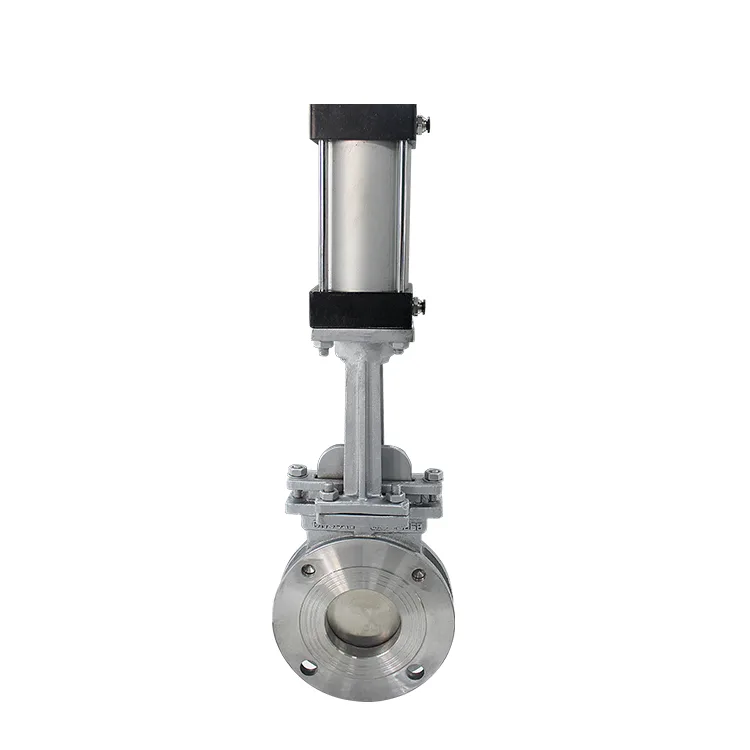
Viskas, ką reikia žinoti apie pneumatinius peilių vožtuvus
Pneumatinio peilinio uždaromojo vožtuvo apibrėžimas:
Pneumatinis peilių vožtuvas yra specializuotas vožtuvas, pirmiausia naudojamas birių medžiagų, srutų ir labai klampių skysčių srautui valdyti. Jis valdomas pneumatine pavara, kuri naudoja suspaustą orą užtvaroms judinti aukštyn ir žemyn, todėl galima tiksliai valdyti srautą. Šie vožtuvai plačiai naudojami tokiose pramonės šakose kaip nuotekų valymas, kasyba, celiuliozės ir popieriaus pramonė bei chemijos pramonė.

Kaip veikia pneumatinis peilių vožtuvas?
Pneumatiniai peilių uždaromieji vožtuvai veikia naudodami pneumatinę pavarą, kuri stumia aštriabriaunį užtvarą per terpės srautą. Pavaros mechanizmą sudaro stūmoklio arba diafragmos kamera, kurioje oro slėgis valdo užtūros judėjimą. Veikiant oro slėgiui, stūmoklis juda, stumdamas užtvarą į priekį arba į priekį, leisdamas arba sustabdydamas skysčio pralaidumą.
Skirtingai nuo tradicinių sklendžių, peilinės sklendės plona geležtė specialiai suprojektuota taip, kad perpjautų storas terpes, įskaitant srutas ir daug skaidulų turinčius skysčius, taip sumažinant užsikimšimą ir užtikrinant sklandų veikimą.
Pneumatinių peilių vožtuvų naudojimo privalumai:
Efektyvus tirštos terpės tvarkymas - sukurtas tankiems tirštiems tirpalams, milteliams ir kietosioms nuotekų medžiagoms pjauti ir kontroliuoti.
Automatizuotas valdymas - suslėgtas oras naudojamas nuotoliniam ir automatizuotam valdymui, taip sumažinant rankų darbą.
Mažai priežiūros - palyginti su kitų tipų vožtuvais, mažiau judančių dalių, todėl jos dėvisi minimaliai.
Kompaktiškas ir lengvas dizainas - lengviau montuoti ir integruoti į vamzdynus.
Didelis patvarumas - paprastai gaminami iš nerūdijančiojo plieno ar kitų korozijai atsparių medžiagų, todėl ilgaamžiškumas užtikrinamas atšiaurioje aplinkoje.
Jokio nuotėkio - daugelyje modelių yra elastingi sandarikliai, užtikrinantys burbuliukų sandarumą.
Dažniausiai naudojami pneumatiniai peiliniai uždaromieji vožtuvai:
Pneumatiniai peiliniai uždaromieji vožtuvai dažniausiai naudojami pramonės šakose, kuriose skysčių valdymas yra labai svarbus:
Vandens ir nuotekų valymas - naudojamas dumblui, smėliui ir kietosioms nuotekų dalims tvarkyti.
Kasyba ir naudingųjų iškasenų perdirbimas - idealiai tinka abrazyvinėms srutoms ir rūdos koncentratams tvarkyti.
Celiuliozės ir popieriaus pramonė - veiksminga popieriaus, celiuliozės ir pluoštinių medžiagų kontrolė.
Cheminės ir naftos chemijos pramonė - naudojami korozijos ir pavojingų skysčių srityse.
Maisto ir gėrimų perdirbimas - skirtas higieniškai tvarkyti tirštus maisto produktus ir atliekas.

Pneumatinių peilinių uždaromųjų vožtuvų tipai:
Yra kelių tipų pneumatinių peilių uždaromųjų vožtuvų, kurių kiekvienas skirtas tam tikroms reikmėms:
Vienkryptis peilio uždaromasis vožtuvas - valdo srautą viena kryptimi, dažniausiai naudojamas esant minimaliam priešslėgiui.
Dviejų krypčių peilių uždaromoji sklendė - gali tekėti srautas abiem kryptimis, idealiai tinka atvirkštiniam srautui.
Peilių uždaromasis vožtuvas su elastinga plomba - minkšta plomba, užtikrinanti sandarų sandarumą ir mažinanti nuotėkį.
Peilio uždaromoji sklendė su metaline sėdyne - tinka naudoti esant aukštai temperatūrai ir dideliam slėgiui.
Vaflinio tipo peilio uždaromoji sklendė - lengva ir kompaktiška, dažnai naudojama vamzdynuose, kuriuose trūksta vietos.
Strypo tipo peilių vožtuvas - turi srieginius įdėklus, kad būtų lengva montuoti ir išmontuoti.
Tinkamo pneumatinio peilių vožtuvo parinkimas:
Norėdami išsirinkti geriausią pneumatinį peilių vožtuvą, atsižvelkite į šiuos veiksnius:
Žiniasklaidos tipas - įsitikinkite, kad vožtuvo medžiaga yra tinkama skysčio savybėms (abrazyvinė, korozinė, klampi ir pan.).
Darbinis slėgis ir temperatūra - pasirinkite vožtuvą, pritaikytą jūsų sistemos slėgiui ir temperatūrai.
Srauto valdymo reikalavimai - Nustatykite, ar reikia vienakrypčio, ar dvikrypčio vožtuvo.
Medžiagos konstrukcija - nerūdijantis plienas, ketus ar kitos medžiagos turėtų būti pasirinktos atsižvelgiant į aplinkos poveikį.
Pavaros sistema - Užtikrinkite suderinamumą su esamomis pneumatinėmis valdymo sistemomis.

Pneumatinių peilinių uždaromųjų vožtuvų montavimas ir priežiūra:
Įrengimo žingsniai:
Prieš montuodami įsitikinkite, kad vamzdynas yra švarus ir jame nėra šiukšlių.
Tinkamai įstatykite vožtuvą į vamzdyną, o jei tai vienakryptis modelis, nustatykite jį pagal srauto kryptį.
Vožtuvą pritvirtinkite naudodami tinkamas tarpines ir varžtus.
Prijunkite pneumatinę pavarą prie oro tiekimo ir valdymo sistemos.
Prieš pradedant naudoti visą sistemą, išbandykite vožtuvo veikimą.
Priežiūros patarimai:
Reguliariai tikrinkite, ar pavaroje ir sandarikliuose nėra oro nuotėkio.
Valykite vožtuvo lizdą ir ašmenis, kad nesusidarytų nuosėdų.
Tepkite judančias dalis, kaip rekomenduoja gamintojas.
Patikrinkite, ar nesusidėvėjo sandarikliai, ir prireikus juos pakeiskite.
Periodiškai tikrinkite, ar vožtuvas tinkamai veikia, ir, jei reikia, sureguliuokite oro slėgio nustatymus.
Pneumatinių peilinių uždaromųjų vožtuvų dažniausiai pasitaikančių problemų šalinimas:
Vožtuvas neužsidaro tinkamai - Patikrinkite, ar ant ašmenų arba sėdynės nėra susikaupę šiukšlių.
Pavaros nereaguoja - Patikrinkite oro tiekimo jungtis ir slėgio nustatymus.
Nuotėkis aplink vožtuvo korpusą - pakeiskite susidėvėjusias tarpines arba sandariklius.
Lėtas vožtuvo veikimas - patikrinkite, ar nėra oro slėgio neatitikimų arba ar neužsikimšusios pavaros linijos.
Per didelis triukšmas veikimo metu - Užtikrinkite tinkamą tepimą ir priveržkite visas atsilaisvinusias sudedamąsias dalis.
Ateities tendencijos pneumatinių peilinių uždaromųjų vožtuvų srityje:
Tobulėjant pramonės automatizavimo ir skysčių valdymo technologijoms, pneumatiniai peilių vožtuvai tobulėja ir pasižymi tokiomis savybėmis kaip:
Išmanieji jutikliai realiuoju laiku atliekamai stebėsenai - Daiktų interneto jutiklių integravimas prognozuojamai techninei priežiūrai.
Patobulintos sandarinimo medžiagos - patobulintų medžiagų kūrimas, siekiant sumažinti susidėvėjimą ir prailginti vožtuvo tarnavimo laiką.
Ekologiškos paleidimo sistemos - naujoviškos energiją taupančios pneumatinės pavaros, mažinančios oro sąnaudas.

Išvados:
Pneumatiniai peiliniai uždaromieji vožtuvai yra esminiai komponentai pramonės šakose, kuriose reikia tiksliai valdyti tirštas terpes ir srutas. Dėl automatizuoto veikimo, ilgaamžiškumo ir minimalios techninės priežiūros jie pasirenkami įvairioms reikmėms. Pasirinkus tinkamą vožtuvą pagal terpės tipą, slėgio reikalavimus ir medžiagos konstrukciją, užtikrinamas optimalus sistemos veikimas ir ilgaamžiškumas.
Suprasdami, kaip šie vožtuvai veikia, kokie jų privalumai ir techninės priežiūros reikalavimai, pramonės atstovai gali padidinti savo veiklos efektyvumą ir patikimumą.
